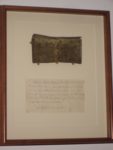Thinking About Heirlooms–52 Ancestors # 8
As my mother aged and started thinking about retiring and downsizing and all that, she began to make lists of the family items she and my father had been given over the years from their families. Some things had come with a death, others had been brought out by the older generation when they visited or when we visited them. While I don’t really know anything about how these people made decisions about passing on treasures, I do have some idea about my mother’s process. I do know that for the generation above my parents, there was little choice: my father was an only child in a family with several “maiden aunt” types and my mother had a single brother. For our family there were 5 children to be considered.
One of the things that was always true of my mother, and verbalized by her, was that she wanted to treat the 5 of us both as individuals and not all alike but also equally. So, for example, some permissions came to each of us at the age my parents (or mother) had decided was most appropriate. Allowances, when we got bigger allowances, what we needed to do with that money, chores, were all laid out. You knew when you would be expected to start being responsible for setting the table or or for clearing it, or helping shovel snow. To the extent she could, the chores and the allowances, were pretty gender-blind among the two girls and three boys. And if there were differences a lot of effort and thought went into making the requirements (frequency, amount of time required) as equivalent as possible while increasing responsibility with age.
This goal of treating us all equally was also noticeable in my mother’s thinking about dividing up the family heirlooms. She made lists. She thought about who should be given something and why. She tried to spread out the various items in terms of kind (silver tableware, trays, pictures, etc.) and based on who they had belonged to originally. She may have asked, occasionally, about whether you wanted this thing or that, but her position was that it was her responsibility to pass them on and she didn’t want to start any family arguments when she was gone, if she could help it.
Now this may make it sound as if there was a huge treasure trove of valuable family heirlooms in her possession. Not so. Also, she started passing items on long before she downsized, so it is difficult in the present to say when something came to me or what she said about it when she gave it to me. I wish I had been more foresighted about keeping track. Many of the most-appreciated-by-me items are pictures and albums, and letters/diaries.
 However, one of the oldest tangible items she passed to me (and I don’t know why I got it as opposed to any of my siblings) is a very old vellum wallet or pocket book. The best thing about this is that it came with an old piece of paper, that gives the provenance for the wallet. We had it framed in a shadow-box with protective glass, and it hangs on my family wall in the dining room.
However, one of the oldest tangible items she passed to me (and I don’t know why I got it as opposed to any of my siblings) is a very old vellum wallet or pocket book. The best thing about this is that it came with an old piece of paper, that gives the provenance for the wallet. We had it framed in a shadow-box with protective glass, and it hangs on my family wall in the dining room.
I know I’ve had it for more than 25 years at this point because in the fall of 1991 I took it to a conservator at Northeast Document Conservation Center to have it looked at. The conservator did not take it out of the sealed shadow-box but by close looking was able to tell me several interesting things about it. The provenance said it was a pocket book originally belonging to Stephen Hussey (c 1630-1718, my 8g grandfather) and passed down to various grandsons and ending up with Theodore Justice in about 1836. What Theodore (my 2 g-grand uncle) did with it on his death is undocumented so far. However it likely stayed with his mother until her death and then with one of her grandchildren who passed it along to my father eventually.

Leave a Reply